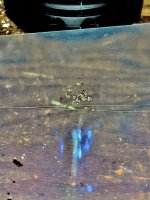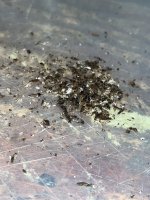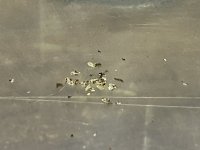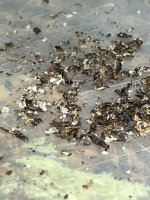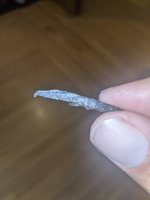I generally follow the rule that if you really have a suspicion of mold you toss the whole container.
Intriguing Crystals, And Odd Smelling Tobacco
- Thread starter IllegitimationStation
- Start date
You are using an out of date browser. It may not display this or other websites correctly.
You should upgrade or use an alternative browser.
You should upgrade or use an alternative browser.
SmokingPipes.com Updates
My advice is to pack it up, and send it to Greeneyes.
Probably Corynebacterium ammoniagenes urease fermentation. A typical microbe in the tobacco fermentation process.
From the paper below: "During a 2- to 3-week fermentation, periodic shuffling of the tobacco bulk is performed in order to improve bulk homogeneity and avoid overheating. Concomitantly, high ammonia levels are generated, likely by proteolysis and/or other processes, contributing to the characteristic alkaline smoke of Toscano cigars."
*
Physiology and Biotechnology
1British American Tobacco Italia, via Cinthia, 80126 Naples, Italy
2Dipartimento di Scienze e Tecnologie Biologiche ed Ambientali, Università di Lecce, via Monteroni, 73100 Lecce, Italy
3Dipartimento di Biologia, Università Roma Tre, viale Marconi, 00146 Rome, Italy
4Unità di Microbiologia Molecolare, Istituto Nazionale per le Malattie Infettive I.R.C.C.S. “Lazzaro Spallanzani,” via Portuense, 00149 Rome, Italy
From the paper below: "During a 2- to 3-week fermentation, periodic shuffling of the tobacco bulk is performed in order to improve bulk homogeneity and avoid overheating. Concomitantly, high ammonia levels are generated, likely by proteolysis and/or other processes, contributing to the characteristic alkaline smoke of Toscano cigars."
*
Physiology and Biotechnology
Microbial Community Structure and Dynamics of Dark Fire-Cured Tobacco Fermentation
Michele Di Giacomo1, Marianna Paolino1, Daniele Silvestro1, Giovanni Vigliotta2, Francesco Imperi3,4, Paolo Visca3,4, Pietro Alifano2, and Dino Parente1,*1British American Tobacco Italia, via Cinthia, 80126 Naples, Italy
2Dipartimento di Scienze e Tecnologie Biologiche ed Ambientali, Università di Lecce, via Monteroni, 73100 Lecce, Italy
3Dipartimento di Biologia, Università Roma Tre, viale Marconi, 00146 Rome, Italy
4Unità di Microbiologia Molecolare, Istituto Nazionale per le Malattie Infettive I.R.C.C.S. “Lazzaro Spallanzani,” via Portuense, 00149 Rome, Italy
ABSTRACT
The Italian Toscano cigar production includes a fermentation step that starts when dark fire-cured tobacco leaves are moistened and mixed with ca. 20% prefermented tobacco to form a 500-kg bulk. The dynamics of the process, lasting ca. 18 days, has never been investigated in detail, and limited information is available on microbiota involved. Here we show that Toscano fermentation is invariably associated with the following: (i) an increase in temperature, pH, and total microbial population; (ii) a decrease in reducing sugars, citric and malic acids, and nitrate content; and (iii) an increase in oxalic acid, nitrite, and tobacco-specific nitrosamine content. The microbial community structure and dynamics were investigated by culture-based and culture-independent approaches, including denaturing gradient gel electrophoresis and single-strand conformational polymorphism. Results demonstrate that fermentation is assisted by a complex microbial community, changing in structure and composition during the process. During the early phase, the moderately acidic and mesophilic environment supports the rapid growth of a yeast population predominated by Debaryomyces hansenii. At this stage, Staphylococcaceae (Jeotgalicoccus and Staphylococcus) and Lactobacillales (Aerococcus, Lactobacillus, and Weissella) are the most commonly detected bacteria. When temperature and pH increase, endospore-forming low-G+C content gram-positive bacilli (Bacillus spp.) become evident. This leads to a further pH increase and promotes growth of moderately halotolerant and alkaliphilic Actinomycetales (Corynebacterium and Yania) during the late phase. To postulate a functional role for individual microbial species assisting the fermentation process, a preliminary physiological and biochemical characterization of representative isolates was performed.Here are better Photos. For you all. Thank you for all your replies so far!
I’m leaning more towards sugar. Attached is a link to a video on this issue, in which I also mention the potential possibility of sodium acetate crystals from the vinegar casing. I think the ammonia smell could just be a highly concentrated pure-vinegar type smell, the kind that burns the nostrils, combined with the already slightly ammonia smelling Rustica. I have even wondered at times if it couldn’t be a mixture of sugar AND sodium acetate at the same time.
After the link to the video is also a link to the Wikipedia page for sodium acetate.
Thanks everyone!
Sodium acetate - Wikipedia - https://en.m.wikipedia.org/wiki/Sodium_acetate
I’m leaning more towards sugar. Attached is a link to a video on this issue, in which I also mention the potential possibility of sodium acetate crystals from the vinegar casing. I think the ammonia smell could just be a highly concentrated pure-vinegar type smell, the kind that burns the nostrils, combined with the already slightly ammonia smelling Rustica. I have even wondered at times if it couldn’t be a mixture of sugar AND sodium acetate at the same time.
After the link to the video is also a link to the Wikipedia page for sodium acetate.
Thanks everyone!
Sodium acetate - Wikipedia - https://en.m.wikipedia.org/wiki/Sodium_acetate
Attachments
Last edited:
Further information about sugar crystals precipitating from acetic acid/vinegar during evaporation over time.
Mixing Sugar and Vinegar - https://www.scientificameriken.com/yr3/print/sugarp.htm
I’m really starting to lean towards sugar at this point, as I’m realizing I’m not sure where the sodium would come from to form sodium acetate. And on second thought, I’m not sure sodium acetate forms by simply evaporating vinegar alone. There would have to be other factors in play. Unless the sodium came from my fingertips, but that’s a heck of a lot of sodium from just skin. I suppose sometimes my hands do sweat. ?
Mixing Sugar and Vinegar - https://www.scientificameriken.com/yr3/print/sugarp.htm
I’m really starting to lean towards sugar at this point, as I’m realizing I’m not sure where the sodium would come from to form sodium acetate. And on second thought, I’m not sure sodium acetate forms by simply evaporating vinegar alone. There would have to be other factors in play. Unless the sodium came from my fingertips, but that’s a heck of a lot of sodium from just skin. I suppose sometimes my hands do sweat. ?
I wouldn't smoke it. After reading through the thread, I realized I don't like my tobacco analysed indepth. Kinda loss the magical side to the whole thing.
Hmm this smell like urine, I wonder if I should smoke it. This is not a thought i would have, this isn't some 1000 dollar cigar you are dreading throwing out. Is it really worth it to even try smoking?
The smell has dissipated, I smoked it. It’s fine and I enjoy it. I never meant to make this about weather or not to smoke it, more about what the crystals are, and I’m almost certain it’s just sugar, and that the ammonia was from rapid decomposition from the jar being in a hot car.
My rule of thumb is if it smells like fish, eat it. If it smells like cologne, leave it alone. If you really like the blend, I'd cut away the affected part and smoke the rest of it looks okay. Otherwise, trash it.
Rustica is certainly not well known for its high sugar content. Hands, on the other hand(no pun intended) are certainly excellent vehicles for fungus transmission. If you rubbed it out with your hands, Occam’s Razor comes to my mind.
Like others have said, this isn’t Esoterica priced tobacco. I would pass on the smoking of it. The world is filled with beneficial and harmless fungi, but get it wrong and the consequences could be severe.
JMHO and YOMV.
Like others have said, this isn’t Esoterica priced tobacco. I would pass on the smoking of it. The world is filled with beneficial and harmless fungi, but get it wrong and the consequences could be severe.
JMHO and YOMV.














